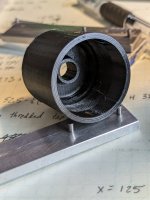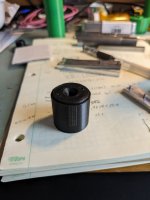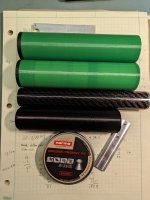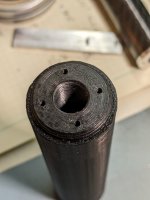Generally for analysis, I just bracket the main peak of the waveform with a generous amount of silence before and after. I'm looking for an excess of ~ 16K samples, give or take, in the whole set. This is assuming there is some level of acoustic silence before and after the waveform. Wind noise, or clicking, cocking the AG, or talking within ~0.5 seconds of the shot is difficult to get rid of.Man! Deciding just exactly where to grab the start of a sample (spotting the uncorking) is HARD without that LASER switch Stan is using! Just whipping my butt here today.
I have just about concluded the lack of a proper triggering device requires deeper statistical analysis unless you just want relational (ranking) data. It is pretty easy to measure them well enough to rank them in order of performance WRT quieting but it's a whole lot harder to get repeatable quantitative data without a deterministic starting point in the shot cycle.
I have shot the end out of one of the glue ups and am going to have to print another endcap. Tomorrow I have to do range safety officer so that day is a down day. I'll get these in the mail by Friday. Word.
Looking at yesterdays dump, I see it has been very difficult to get non clipped shots. You do have some unclipped shots, so I will look at them. (Unfortunately we cannot get a statistically meaningful sense since the number of data sets is too low. For that one would need at least 22 good shots, which is far beyond what either I or anyone else would deem reasonable to collect.)
This means, probably, that the microphones are still a tad too close. I realize it is a battle between dynamic range of the mic and getting meaningful data. Remember, we get process gain by using an FFT and can observe features below the noise floor. I used to do this regularly in my radar work. Also remember, from Parseval's theorem we can recover the total energy in either domain, simply by summing the squares of the signal and adding them up. To make the spectral energy equivalent to the time domain is a simple multiplicative factor. It may be advantageous to measure the energy in the frequency domain, since the final bandwidth of each FFT bin is N times less than the the sample rate, where N is the size of the FFT. This means the SNR of each of the bins is effectively N times greater than a single sample in the time domain, since we are simultaneously using all the samples in the spectral domain. The downside of using the spectral domain is time information has been "erased". But energy is energy, no matter which domain. And we know that higher frequencies correspond to the crack that we hear. We humans DF (direction find) pretty well on higher frequencies rather than lower bass like frequencies.
Upvote 0



